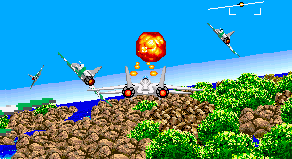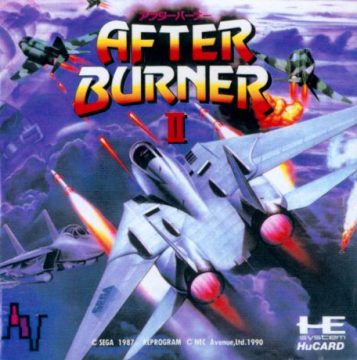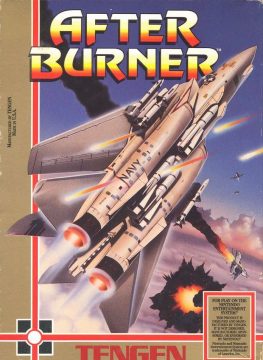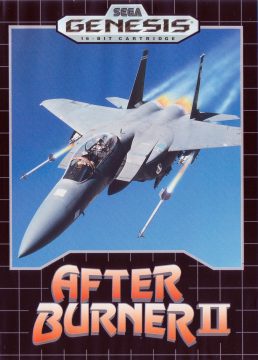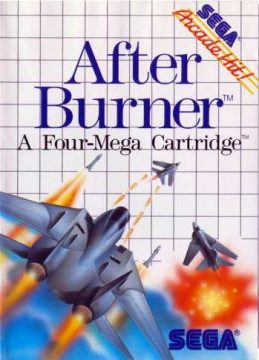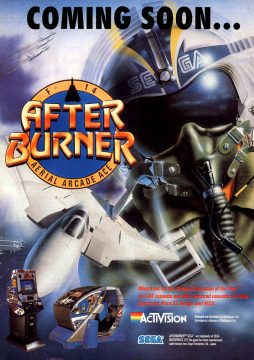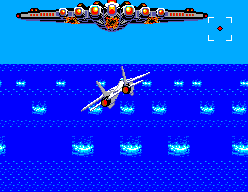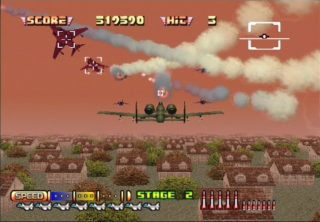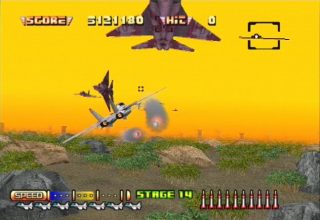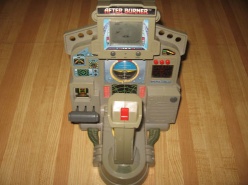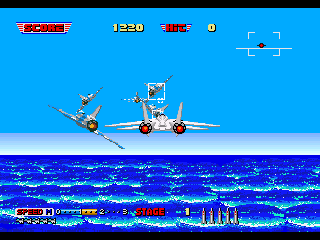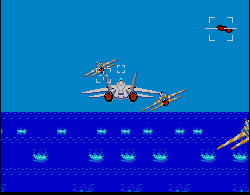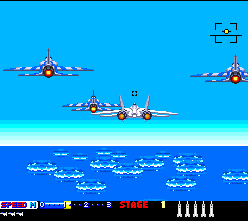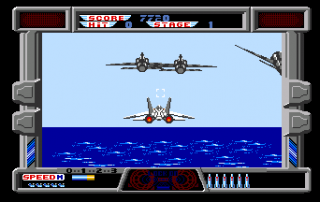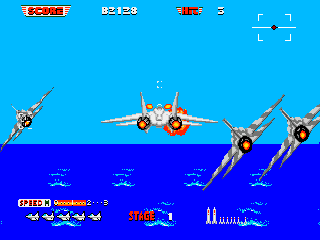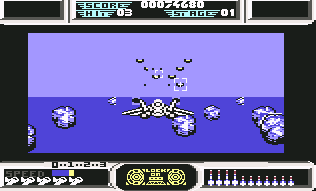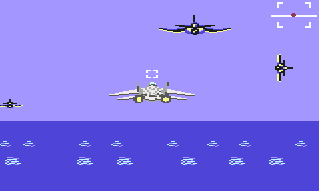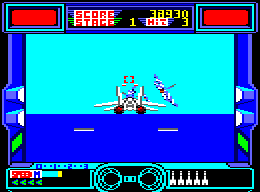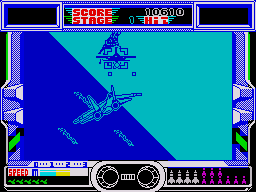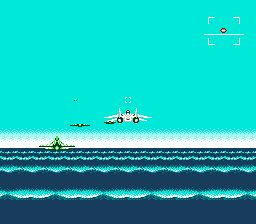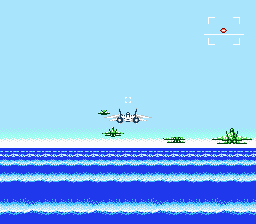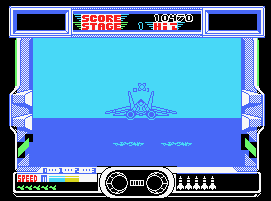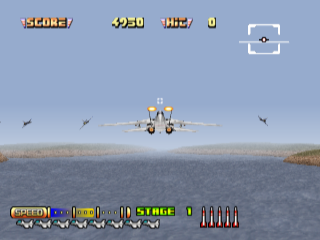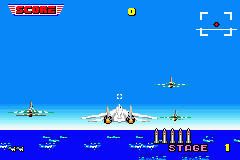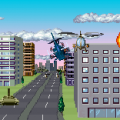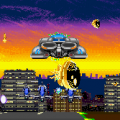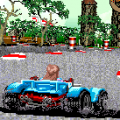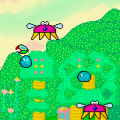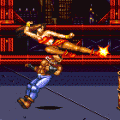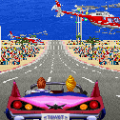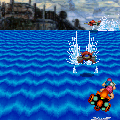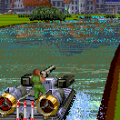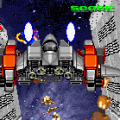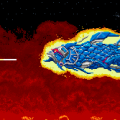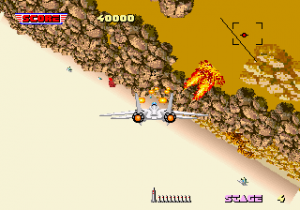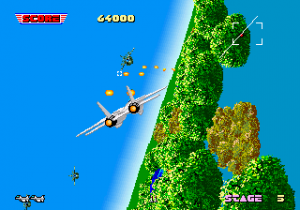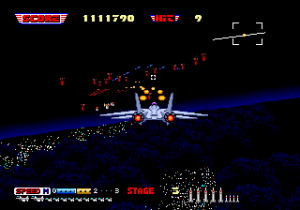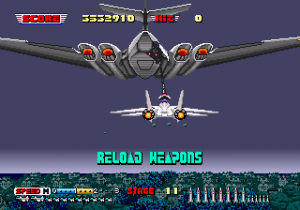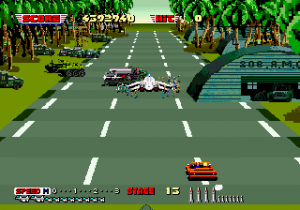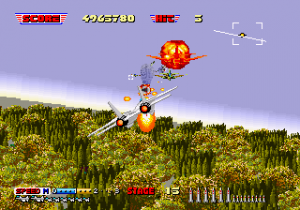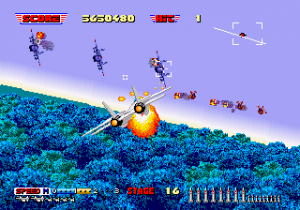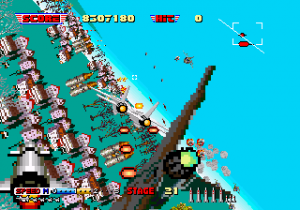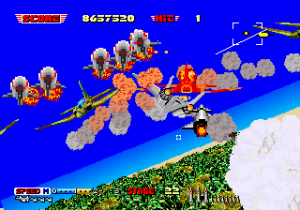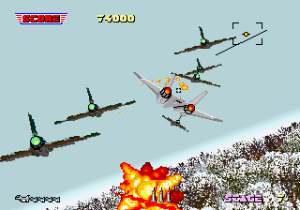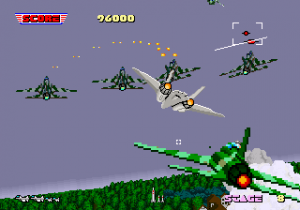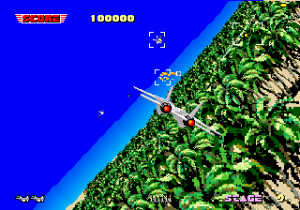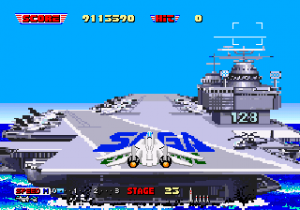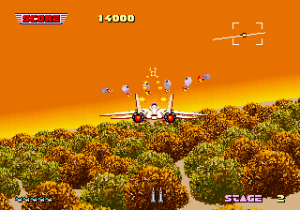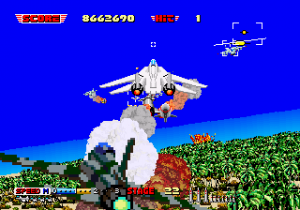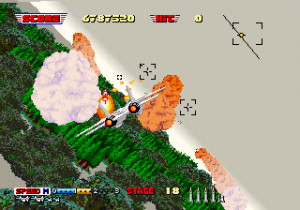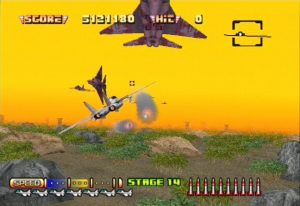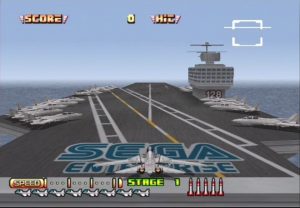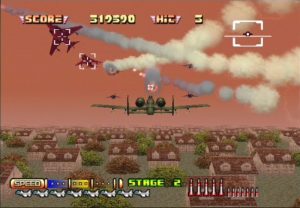Sega’s After Burner, an aerial combat game released in 1987, ditches complexity in favor of straightforward action. Prior to this, 3D airplane games were all mind numbing computer flight-sims and ran at a crappy framerate. Running on Sega’s “super scaler“ technology, After Burner uses incredibly smooth pseudo-3D effects to propel arcade gamers into the cockpit of a jet similar to the F-14 Tomcat. The sole goal is to blow up as many bad guys as possible while trying to stay in one piece, all set to gloriously cheesy synth rock music. It’s undoubtedly inspired by Top Gun, just minus Tom Cruise and all of the homoerotic undertones (also far better than any of the actual Top Gun games, of which there are far, far too many).
After Burner and After Burner II are both powered by the Sega X board, which is an improvement over the boards that ran previous “super scaler“ games like OutRun and Space Harrier, all directed by Yu Suzuki. The controls in the first game are fairly limited: you can climb, descend, and rotate your plane. Turning back and forth rapidly will send your plane spinning dizzily, which looks cool but ultimately doesn’t do much. It’s impossible to crash into the ground, and for the most part, you don’t need to worry about anything but dodging enemy fire. Your primary weapon is heat-seeking missiles – just line up an incoming enemy fighter with your crosshairs, wait for the “lock-on“ to appear (usually accompanied by a frantic voice yelling “Fire!“) and hit the fire button. Unfortunately, missiles are in limited supply, so you’ll need to rely on your Vulcan cannons for easier enemies. Trying to hit anything with bullets is nearly impossible unless your target’s at close range, so conserving your missiles is extremely important. Thankfully, every few stages, a friendly plane comes by and replenishes your stock.
There’s very little variety; there are a few stages set in a canyon, where you need to weave between the walls, but these are really just bonus stages. Other than the color of the sky and the changing landscapes, the core game never changes, but that’s not really important, because After Burner excels at throwing all kinds of crazy stuff in your face. At its best moments, you need to keep enemy fighters in your targets, dodge incoming missiles, and attempt to keep track of your own airplane amidst the explosions and smoke trails, all while the scenery is rocketing by, rotating completely out of control. The sense of speed is still unrivaled by most video games even today.
There are also some damn nice explosions – get hit by enemy fire and your engines will smoke as you careen downwards, creating a line of fire and destruction as you hit the ground. Later games in the series had even more impressive death sequences, with plenty of seizure-inducing screen flashing. The soundtrack, per usual protocol during the mid-1980s, is absolutely brilliant. The FM synth of Sega’s arcade boards manages to produce some incredibly rocking tunes, and while there are only a handful of songs, all composed by Hiroshi Kawaguchi, they are all quite memorable.
Alas, After Burner’s greatest asset is also its biggest flaw – it’s ridiculously crazy to play. Since your movement range is so limited, and the screen can get very crowded, it becomes incredibly difficult to make your way through later stages without crashing and burning every few seconds. Still, this was originally an arcade game, designed to provide some impressive thrills for a few coins, and nowhere was this more apparent than the cabinet design.
The first release had a replica of a flight stick, and the second game had a model throttle that let you control you speed. Many sit-down cabinets even tilted as you rotated your plane. In this respect, After Burner is really more of a ride than a legitimate game, which is maybe why it doesn’t quite hold up compared to other Sega arcade games around the same time. But taken as what it is, it’s nice, flashy fun.
Strangely enough, there are very few differences between After Burner and After Burner II – in fact, the latter isn’t so much a sequel as it is a minor upgrade. After Burner II has a fancier intro (featuring a series of rotating spheres), some new enemies, and a handful of extra levels, increasing the total number from 18 to 23 missions.
Sega also added little intermissions where your plane lands to rearm, which include cameos by the motorcycle from Hang-On and the Ferrari from OutRun. The biggest addition is the throttle control that lets you speed up or slow down. Enemy planes will occasionally pop up on your tail, and using the throttle can either help blow past them or have them overshoot you so you can deliver a killing shot. The only other noticeable difference is that you’re granted more missiles, both when you start and when you refuel. This makes the game easier, and overall less frustrating.
There are also some minor differences in the instrumentation of the music, although the soundtracks are essentially identical. Furthermore, there are also “melody“ versions of three of the songs – “Maximum Power“, the title theme, plus “After Burner“ and “Final Take Off“. These versions feature an extra melody track during most of the song, and greatly enhance them, to the point that the original compositions feel rather empty. While these are not used in-game for the arcade version, they were featured on various soundtrack CDs, and were used as a basis for some of the console version soundtracks, including the SMS, PCE and FM Towns ports.
The Sega Master System was the first console to be graced with a port of After Burner, but given the limitations of the system, it wasn’t particularly good. It looked great at the time – Sega hyped it up as being one of the first “Four Mega“ cartridges (4 megabits or 512kb). The choppy graphics made it far too difficult to see what you were supposed to be dodging, which essentially ruins the experience. There’s also a bug that lets you stay in one corner and dodge all enemy fire until about halfway through the game. On the plus side, you have unlimited missiles, since hitting anything with your guns is nearly impossible. As such, the refueling segments have been repurposed into bonus stages, where you try to hook up with the larger jet’s fueling hose for extra points. While the canyon levels have been removed, Sega added in a final boss called the Grantanoff, which is a flying fortress that feels somewhat out of place.
An NES version was ported by Tengen for American release, but it’s substantially worse than the Master System version. The sprites are smaller and there’s tons of flickering, making it borderline unplayable. Sunsoft cleaned up the game to remove the flicker, enhanced the music, and changed the color palette around to release it on the Famicom under the name After Burner II.
When the 16-bit era rolled around, After Burner II was ported to the Genesis by the third-party developer Dempa. The system still wasn’t strong enough to handle the scaling effects, and while it looks relatively decent, many of the backgrounds have lost a lot of detail, and the pace isn’t quite as fast. The horizontal controls also don’t snap back to a center position, which makes it hard to keep the plane level, undoubtedly a concession to the digital control pad. By default, the machine gun is also set to auto-fire, as the three buttons are used to fire missiles, speed up and slow down. There’s plenty of flicker, though the music is decent enough.
Oddly enough, the PC Engine version – ported by NEC Avenue – has brighter graphics and smoother gameplay, though the background detail has been reduced even further, and there is a substantial amount of flicker. It uses an odd sprite stretching technique in order to replicate the scaling effect. It also controls better than the Genesis version, and the music, rearranged for the PC Engine synth, is excellent.
The 32X version – dubbed After Burner Complete, even though it’s really just After Burner II – is nearly arcade perfect, complete with smooth scaling and faithful music. It even offers support for the six button pad, so you can more easily change speed or even roll. The only noticeable difference is that it runs at 30 FPS rather than 60 FPS like the original arcade version.
The Saturn rendition of After Burner II is even better than the 32X version, offering both analog and digital control options, as well as a smooth 60 FPS framerate. It was released in the Sega Ages package along with Space Harrier and OutRun in America and Europe, though it was a standalone disc in Japan. The Japanese release also includes the “melody“ versions in addition to the standard music.
After Burner also appears in emulated form in Shenmue II for the Dreamcast and Xbox. It plays well, but lacks options, plus the upscaled graphics are a bit on the blurry side.
In 2003, Sega published the Sega Arcade Gallery, which offered four arcade classics, ported by Bits Studios, for the Game Boy Advance. After Burner is one of the four included, though it’s an absolutely terrible port. While the scrolling is smooth, the sprites are tiny, the background detail is worse than the Genesis version, and the controls are remarkably poor. The Vulcan cannon in particular has completely changed, and the whole game just feels off. Oddly enough, this version is based on the original After Burner, rather than After Burner II.
After Burner appeared on practically every major computer in the late 1980s. Activision published many of these versions in Europe for the Amiga, Atari ST, Commodore 64, IBM PC, MSX, ZX Spectrum and Amstrad CPC. None of these ports are particularly good – they’re all framed in the same ugly window, the graphic details are poor, and the action is choppy.
These problems are understandable with the ZX Spectrum and MSX ports, which are largely identical to each other. Both feature black outlines for sprites and incredibly choppy scrolling. The MSX has a slight advantage in that it has music, but neither are particularly good. The Amstrad CPC release is more colorful, while the C64 version has an excellent soundtrack courtesy of Adam Gilmore.
The crappiness, however, is far more evident in the Amiga and Atari ST releases. The sprites look decent, but it’s lacking in both speed and smoothness. The IBM PC version, despite running with 16 colors, is the best looking of the computer versions, relatively speaking, though it’s stuck with awful sound.
In North America, though, the C64 and Amiga versions were completely redone, and are, generally, far better efforts. The C64 version is now full screen, and while it’s still slow and choppy it’s not nearly as awful, and is roughly on the level of the Sega Master System port. The only downer is the lack of in-game music. Similarly, the Amiga version is comparable to the Genesis release. There’s a bit more scenery in the Amiga version, but the music hasn’t been terribly well converted.
There were two home computer ports in Japan, for the FM Towns and Sharp X68000. The FM Towns conversion was handled by CRI, who also ported a number of other Sega games to Fujitsu’s platform. While the scaling isn’t quite as smooth as the arcade version, it is still better than any of the 8- or 16-bit console ports, and also includes an excellent arranged soundtrack, exclusive to this version of the game.
The Sharp X68000 was ported by Dempa, who had also developed the Genesis version. The scrolling is fairly smooth, although the number of sprites have been reduced, and the music is a close approximation of the arcade original.
After Burner II was also ported to the PlayStation 2 in 2004 as part of the Sega Ages 2500 series, which replaced the sprite-based graphics with polygonal models. A lot of the graphical luster displayed by the original was lost in the translation to 3D, so much of the game looks rather ugly. Despite technically running at a higher resolution and with more advanced polygonal models, the overall look is worse than Sky Target, and that game is on the Saturn.
Still, the gameplay has held up almost perfectly, and the sense of speed is still intact, so it’s not a complete waste. Unfortunately, none of the music is arranged, and just uses tracks straight from the arcade. There’s also an “Arrange Mode“ that lets you pilot three other aircraft, including an AV-8B Harrier II, the A-10A Thunderbolt II (a bomber), and the F-117 Nighthawk (a stealth jet), although the differences between them are pretty minor. Oddly enough, this release was excluded from the Sega Classics Collection that was brought over to America and Europe, so the only way to play it is to snag the Japanese version.
That accounts for all of the official releases but, in 2003, an Italian development team called Brodaroda developed their own homebrew version for Windows and released it for free. As to be expected from an amateur endeavor, it’s not particularly good, with untextured graphics that are even worse than the PlayStation 2 effort, numerous control glitches, and plane movement that doesn’t feel right.
The 3DS version was released in 2013 and includes numerous enhancements, including widescreen view, translucent smoke effects, and simulated cabinet motions like the other 3DS Sega ports. Melody versions of the music tracks are present. There is an added “Special Mode” – you cannot continue or use the level select, but enemies are more numerous and you gain many extra lives for racking up points. Also new is a Burst gauge similar to the later After Burner Climax that lets you slow down time. as well as “rival” dogfights that replace the canyon stages. Additional enhancements include a goofy story mode, with little messages that pop up between rounds detailing the adventures of your character, Jerry, as he hunts for his kidnapped pal Tom.
In 2007, Wave Master released a six CD compilation of music from the After Burner series. Most of the tracks are from the various ports of the original game – outside of the arcade original, included are the Master System (PSG and FM), Famicom, PC Engine, Game Boy Advance, 32X, FM Towns, Genesis, Dreamcast, X68000, and mobile phone versions. The second disc contains the music from After Burner Climax, and the sixth disc includes various “cameo” tracks from other Sega games, including Segagaga, Rent-A-Hero No. 1, Daytona USA, and the one After Burner track from Sky Target, as well as several arragend versions. There’s no doubt it’s a sleek package, but some of the variations are so slight (particularly the 32X and Dreamcast version) that their inclusion is redundant and seems to just pad out the package.
While many Sega games were scaled down into Tiger handheld electronic games, After Burner also got extra version, a standalone unit shaped like a miniature cockpit. The flight stick is obviously small, the plastic is cheap, and the tiny LCD is the same as every other Tiger toy, but it’s a cool artifact nonetheless.
In 2005, Japanese doujin group DNA Software developed Master Burner, a clone of After Burner featuring Touhou characters. It looks, plays, and even sounds almost identical to the original arcade game, with some minor tweaks, and some boss battles against other Touhou girls. In 2011, three developers – Shooting Area, Aquaelie and Hexaflange – collaborated a sequel, Master Burner Climax, which is entirely in 3D.
Links
After Burner Climax Official Site Tons of pictures.
Insomnia.ac Detailed review of After Burner Climax.
After Burner Station Never finished, but a good start for a fansite.
Sega 16 – After Burner III Review of this sorry game.
Wikipedia – After Burner 2 Details some of the changes between the first and second games.
